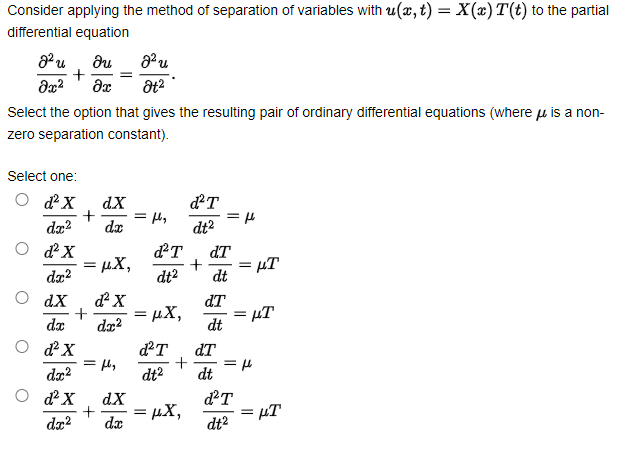differential equation + Select the option that gives the resulting pair of ordinary differential equations (where u is a non- zero separation constant). Select one: O X dX = H, dz? dx = / dt? O &X = µX, dz? dT = µT dt dt2 O dX + dz dT = µX, dr? = µT dt O &X d²T dT = l, dr? dt? dt O &X dX + dz = µX, = µT dt2 dr?
differential equation + Select the option that gives the resulting pair of ordinary differential equations (where u is a non- zero separation constant). Select one: O X dX = H, dz? dx = / dt? O &X = µX, dz? dT = µT dt dt2 O dX + dz dT = µX, dr? = µT dt O &X d²T dT = l, dr? dt? dt O &X dX + dz = µX, = µT dt2 dr?
Linear Algebra: A Modern Introduction
4th Edition
ISBN:9781285463247
Author:David Poole
Publisher:David Poole
Chapter4: Eigenvalues And Eigenvectors
Section4.6: Applications And The Perron-frobenius Theorem
Problem 69EQ: Let x=x(t) be a twice-differentiable function and consider the second order differential equation...
Related questions
Question
100%
q7

Transcribed Image Text:Consider applying the method of separation of variables with u(x, t) = X(x) T(t) to the partial
differential equation
%3D
Select the option that gives the resulting pair of ordinary differential equations (where u is a non-
zero separation constant).
Select one:
O dX
dX
dT
dz?
dx
dt2
O dX
= µX,
dæ?
dT
µT
dt
dt?
O dX
+
da
dT
= µT
dt
= µX,
%3D
O dX
dT
+
dt?
dT
= l,
da?
dt
O dX
dX
=µX,
da
= µT
dt2
dr?
Expert Solution
This question has been solved!
Explore an expertly crafted, step-by-step solution for a thorough understanding of key concepts.
This is a popular solution!
Trending now
This is a popular solution!
Step by step
Solved in 2 steps with 2 images

Recommended textbooks for you

Linear Algebra: A Modern Introduction
Algebra
ISBN:
9781285463247
Author:
David Poole
Publisher:
Cengage Learning

Linear Algebra: A Modern Introduction
Algebra
ISBN:
9781285463247
Author:
David Poole
Publisher:
Cengage Learning